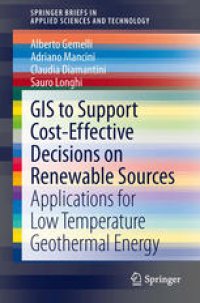
Ebook: GIS to Support Cost-effective Decisions on Renewable Sources: Applications for low temperature geothermal energy
- Tags: Geoengineering Foundations Hydraulics, Renewable and Green Energy, Energy Policy Economics and Management, Energy Efficiency (incl. Buildings)
- Series: SpringerBriefs in Applied Sciences and Technology
- Year: 2013
- Publisher: Springer-Verlag London
- Edition: 1
- Language: English
- pdf
Through the results of a developed case study of information system for low temperature geothermal energy, GIS to Support Cost-effective Decisions on Renewable Sources addresses the issue of the use of Geographic Information Systems (GIS) in evaluating cost-effectiveness of renewable resource exploitation on a regional scale. Focusing on the design of a Decision Support System, a process is presented aimed to transform geographic data into knowledge useful for analysis and decision-making on the economic exploitation of geothermal energy. This detailed description includes a literature review and technical issues related to data collection, data mining, decision analysis for the informative system developed for the case study. A multi-disciplinary approach to GIS design is presented which is also an innovative example of fusion of georeferenced data acquired from multiple sources including remote sensing, networks of sensors and socio-economic censuses. GIS to Support Cost-effective Decisions on Renewable Sources is a useful, practical reference for engineers, managers and researchers involved in the design of GIS, decision support systems, investment planning/strategy in renewable energy and ICT innovation in this field.
Through the results of a developed case study of information system for low temperature geothermal energy, GIS to Support Cost-effective Decisions on Renewable Sources addresses the issue of the use of Geographic Information Systems (GIS) in evaluating cost-effectiveness of renewable resource exploitation regional scale. Focusing on the design of a Decision Support System, a process is presented aimed to transform geographic data into knowledge useful for analysis and decision-making on the economic exploitation of geothermal energy. This detailed description includes a literature review and technical issues related to data collection, data mining, decision analysis for the informative system developed for the case study. A multi-disciplinary approach to GIS design is presented which is also an innovative example of fusion of georeferenced data acquired from multiple sources including remote sensing, networks of sensors and socio-economic censuses. GIS to Support Cost-effective Decisions on Renewable Sources is a pratical reference for engineers, managers and researchers involved in the design of GIS, decision support systems, investment planning/strategy in renewable energy and ICT innovation in this field.
Through the results of a developed case study of information system for low temperature geothermal energy, GIS to Support Cost-effective Decisions on Renewable Sources addresses the issue of the use of Geographic Information Systems (GIS) in evaluating cost-effectiveness of renewable resource exploitation regional scale. Focusing on the design of a Decision Support System, a process is presented aimed to transform geographic data into knowledge useful for analysis and decision-making on the economic exploitation of geothermal energy. This detailed description includes a literature review and technical issues related to data collection, data mining, decision analysis for the informative system developed for the case study. A multi-disciplinary approach to GIS design is presented which is also an innovative example of fusion of georeferenced data acquired from multiple sources including remote sensing, networks of sensors and socio-economic censuses. GIS to Support Cost-effective Decisions on Renewable Sources is a pratical reference for engineers, managers and researchers involved in the design of GIS, decision support systems, investment planning/strategy in renewable energy and ICT innovation in this field.
Content:
Front Matter....Pages i-ix
Decision Environment of Renewable Energy: The Case of Geothermal Energy....Pages 3-17
GIS-Supported Decision Making....Pages 19-32
GIS-Supported Decision Making for Low-Temperature Geothermal Energy in Central Italy....Pages 35-38
Data Collection....Pages 39-45
Feature Analysis: Selecting Decision Criteria....Pages 47-65
Decision Analysis: Choosing the Right Plant....Pages 67-69
Regional Atlas Supporting the Decision-Making Process....Pages 71-81
Conclusive Remarks....Pages 83-84
Through the results of a developed case study of information system for low temperature geothermal energy, GIS to Support Cost-effective Decisions on Renewable Sources addresses the issue of the use of Geographic Information Systems (GIS) in evaluating cost-effectiveness of renewable resource exploitation regional scale. Focusing on the design of a Decision Support System, a process is presented aimed to transform geographic data into knowledge useful for analysis and decision-making on the economic exploitation of geothermal energy. This detailed description includes a literature review and technical issues related to data collection, data mining, decision analysis for the informative system developed for the case study. A multi-disciplinary approach to GIS design is presented which is also an innovative example of fusion of georeferenced data acquired from multiple sources including remote sensing, networks of sensors and socio-economic censuses. GIS to Support Cost-effective Decisions on Renewable Sources is a pratical reference for engineers, managers and researchers involved in the design of GIS, decision support systems, investment planning/strategy in renewable energy and ICT innovation in this field.
Content:
Front Matter....Pages i-ix
Decision Environment of Renewable Energy: The Case of Geothermal Energy....Pages 3-17
GIS-Supported Decision Making....Pages 19-32
GIS-Supported Decision Making for Low-Temperature Geothermal Energy in Central Italy....Pages 35-38
Data Collection....Pages 39-45
Feature Analysis: Selecting Decision Criteria....Pages 47-65
Decision Analysis: Choosing the Right Plant....Pages 67-69
Regional Atlas Supporting the Decision-Making Process....Pages 71-81
Conclusive Remarks....Pages 83-84
....